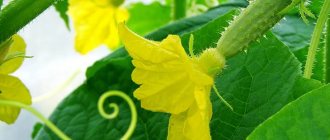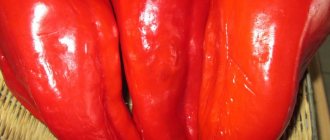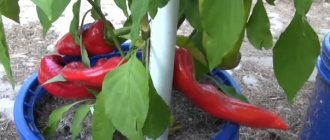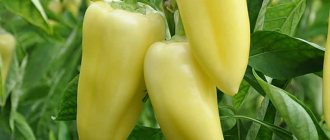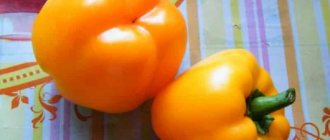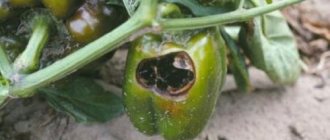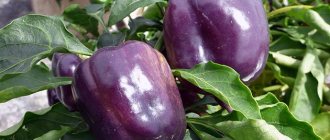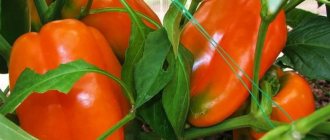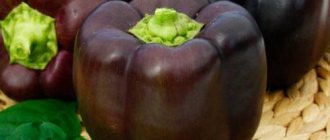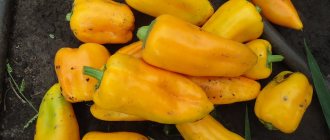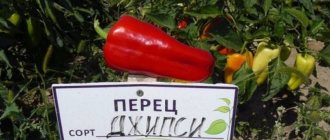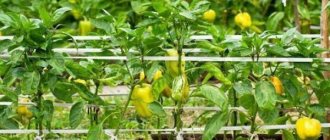Early bird is a sweet pepper listed in the Russian State Register in 2009. This variety is attractive to gardeners because when describing it, breeders point to early ripening and excellent resistance to weather anomalies. The article will reveal the external signs of the crop and the nuances of its cultivation. The reader will also get acquainted with how farmers speak about the vegetable.
Description of the variety
Pepper Early Bird is a low-growing crop with a semi-bouquet type of ovary formation. The average length of the stems is 40 cm. The leaves are of the usual ovoid format. The pepper on the bushes is positioned with the tip up.
The fruit is an almost even cone, since its ribs are almost invisible. In the photo you can see a vegetable that has reached the last stage of maturity. This pepper has a red color. Until final ripeness, it has a faint green tint.
The average weight of the vegetable is 120 g. The length of the pepper reaches more than 10 cm. The walls are not particularly massive - 5 - 6 mm. Seed chambers – 2.
| Type of growth, bush height | Standard, 40-42 cm |
| Ripe fruit color | Red |
| Planting scheme | 1 m2 - up to 5 plants |
| Weight, length and shape of the fruit | about 120 g, more than 10 cm, cone-shaped |
| Ripening period, yield | Early ripening (90 – 110 days), 4 – 5 kg/m2 |
| Drop off point | exhaust gas/greenhouse/greenhouse |
| Diseases | Bushes need to be treated with standard pest and disease control products. |
| By type of use | Universal |
| Flowering type | Mixed |
Varieties for open ground
We advise you to pay attention to the following early varieties of peppers for open ground:
- Early bird . Early ripening pepper variety for open ground and film shelters. Early bird pepper is semi-bouquet, up to 40 cm high. The fruits are cone-prismatic, weighing up to 120 g, light green at technical maturity, biologically red, with a wall thickness of up to 6 mm.
- Sweet Funtik. Height is 50-70 cm. It itself has a brown or red fruit color with a rich tint. One pepper can weigh from 100 g to 180 g. One bush can produce 16 peppers, so the harvest is considered average.
- Lumina. This type of pepper is considered the most common among others. The bush grows small, but the weight of one pepper does not exceed 115 grams. It differs from the previous class in being slightly golden or light green in color with a slight hint of pink. The shape of the pepper is conical, and the wall thickness of the pepper is on average 6 mm. It does not produce a strong pronounced aroma, and the taste is sweetish with an admixture of water.
- Ivanhoe. The variety was introduced relatively recently, but has already spread among the early varieties of pepper. After the shoots appear, you can count 110 days and you will get the first results that you can eat. Of course, the taste will be different from a fully ripened pepper. At this stage it is white or slightly cream in color. Fully matures in an average of 130 days.
- Marinkin Tongue. It is well adapted to unfavorable growing conditions, and the yield is always high. It is because of this that in the summer residents often choose the “Marinkin Tongue” variety. About 15 peppers, the weight of which is large, can grow on one bush. The average weight is up to 195 grams, and large vegetables weigh up to 250 grams.
Advantages and disadvantages
The main advantages of the variety are as follows:
- Pepper quickly adapts to cold weather, strong winds, and significant heat.
- The bushes are low, so they can be grown without a garter.
- The fruits are convenient for cooks because they fit well into containers for canning; their wall thickness is sufficient for stuffing and salad consumption.
- The harvest ripens early, so the pepper has time to ripen in regions where the summer is short.
- The crop bears fruit in greenhouses and open ground.
- To propagate the variety, you can collect seeds from your own vegetables.
Pepper is not without its disadvantages:
- its productivity cannot be called exceptional;
- the originator did not instill in the crop any special resistance to any disease, therefore, under equal conditions, the variety has a greater chance of contracting an infection than many hybrids.
Sowing seeds for seedlings | Planting seedlings in a greenhouse/greenhouse | Planting seedlings in exhaust gas | Stepsoning | Harvesting |
| March | Mid May | June | Cutting leaves and shoots to the first fork | From the beginning of July |
| *dates are indicated for central Russia | ||||
Varieties for Siberia
The following varieties are suitable for more severe conditions:
- Kolobok . The culture of Moldovan breeders is ideally adapted to the conditions of Siberia. An early variety of pepper bears fruit well in open ground. It is distinguished by a short bush that is easy to care for. The three- and four-chambered fruits have tender red flesh that is about 9mm thick. The maximum weight of one pepper is 90 g.
- Topolin . The plant may have two stems, resulting in a tall bush that requires staking to a trellis. The first crop can be removed 110 days after germination. Green peppers turn red when ripe. The fruits are not fleshy with thin walls, weighing no more than 150 g. If measured on a large scale, then from 1 hectare you can harvest about 50 tons of crop, which is 5 kg/m2.
- Novosibirsk . An early ripening variety of pepper is bred for cultivation in Siberia. After 2 months, seeds sown in February produce strong seedlings that can be transplanted into a greenhouse. After 95 days it produces the first peppers. As for the yield, from 1 m2 you can get about 4 kg. The bushes grow up to 1 m in height, producing peppers weighing up to 58 grams with aromatic red flesh 6 mm thick.
- An early miracle . The culture belongs to the early fruiting period. Ripe fruits can be obtained 90-105 days after germination. The variety is immune to viral diseases. The bush can grow up to 1.2 m, which requires garter. When ripe, the pepper turns red.
Read also: How to grow rice at home
- Montero . The bush up to 1.2 m high is suitable for growing in any type of greenhouse. The fruits are very large, the pulp thickness is 7 mm and weighs about 260 g. With good feeding, you can grow giant peppers weighing up to 940 g. The variety is considered high-yielding, since 7-6 kg of fruit can be harvested from 1 m2.
Features of agricultural technology
The recommended method for growing vegetables is seedlings. The following steps must precede the harvest:
- sowing seeds 70 days before the expected date of transfer of seedlings to a permanent place;
- preliminary hardening of seedlings for 7 – 10 days;
- regular watering, at the rate of 4 - 6 liters of liquid per 1 mature plant;
- shallow loosening of the soil under bushes (immersion of the tool up to 6 cm);
- 3 – 4 fertilizing with mineral fertilizers (pepper is enriched for the first time 2 weeks from the day of planting).
Advice. If the gardener notices that after setting several fruits the bushes have completely stopped blooming, it is necessary to remove these vegetables. This measure will rehabilitate the pepper and provoke the formation of new buds.
Varieties for the northwest
We suggest you familiarize yourself with the following varieties.
Tenderness
The culture is considered universal due to its ability to adapt to any climate. Bushes under the roof grow up to 1 m in height, requiring garter. The period of fruit ripening is considered medium-term. The first crop is removed 115 days after emergence. The shape of the vegetable resembles a pyramid with a truncated tip. The fleshy pulp, 8 mm thick, turns deep red when ripe. Ripe pepper weighs about 100 g. When grown in a greenhouse, the yield is 7 kg/m2.
Gift from Moldova
The plant produces a harvest of ripe peppers 120 days after shoots, which defines it as a mid-early variety. Low shrubs grow to a maximum of 45 cm in height, densely packed. Cone-shaped peppers have an average pulp thickness of about 5 mm, covered with smooth skin. When ripe, the light pulp turns red. The weight of a mature vegetable is about 70 g. The yield is good; from 1 m2 you can harvest about 4.7 kg of pepper.
Chrysolite F1
After germination of seedlings, the first mature harvest will appear in 110 days. The culture belongs to early hybrids and is intended for cultivation in a greenhouse. The tall plant is not heavily covered with foliage, the branches spread out, requiring staking. Large fruits with a slightly ribbed appearance, with 3 or 4 seed chambers inside the shape. The pulp is juicy, 5 mm thick, covered with smooth skin. The weight of a mature pepper is about 160 g.
Read also: How to properly salt honey mushrooms
Agapovsky
The greenhouse predestination culture brings an early harvest, about 100 days after seedling germination. Medium tall bushes are densely covered with foliage, the crown is compact. The shape of the vegetable resembles a prism, the ribs are slightly visible along the walls. Up to 4 seed nests are formed inside. When ripe, the green pulp turns red. Ripe pepper weighs about 120 g. The fleshy pulp, 7 mm thick, is very rich in juice. Productivity of the highest grade, from 1 m 2, 10 kg of vegetables are harvested.
Ruza F1
The fruits of this early hybrid ripen in greenhouse conditions 90 days after germination. A tall, medium-sized bush covered with foliage. Cone-shaped peppers, with smooth skin and slightly visible ribs, turn red on the walls when ripe. In a cold shelter, pepper grows weighing about 50 g. A hybrid grown in a heated greenhouse produces large fruits weighing up to 100 g. The juicy fruit has a wall thickness of about 5 mm.
Reviews
Summer residents often share their opinions about the variety. In reviews, the vegetable is given the following characteristics:
- Early Bird grows as a small bush. The pepper is juicy and ripens early. Suitable for stuffing, summer salads - Nina from the Nizhny Novgorod region.
- Vegetables on the bush are the same size - gardener Mariel.
- The pepper is very sweet and tasty - a gardener under the nickname “Red Flower”.
- The variety is productive. About 15 fruits ripen on one crop at once - summer resident Lyudmila.
The early bird is a pepper with a short ripening period and high resistance to bad weather. Despite the average yield, the vegetable has considerable success among farmers.
Varieties for greenhouses
We believe that the following early varieties of peppers for greenhouses will appeal to any summer resident:
- Hercules. Fruits up to 300 g, cube-shaped, with pronounced ribs. Has excellent immunity. Can be stored for a long time and is recommended for sale. Up to 3.5 kg of vegetables are harvested per square meter.
- Claudio - matures in an average of 118 days. Diversity of Dutch selection. The bush grows up to 130 cm, powerful, rather stretched. The fruit weighs up to 250 g, dark red, after complete aging. The shape is elongated, conical. It is not afraid of all the main and most famous and dangerous diseases of pepper. From 1 m2 per season, up to 2.5 kg of pepper is harvested.
- Atlant . Ripens in 105-115 days. It grows to a height of 65-80 cm. The fruit has a high juice content, a thick wall and good flavor indicators. The color is initially green, but changes to bright red when fully ripe. The average yield is 5 kg/m2.
- Health is an early version of sweet peppers for growing in any type of greenhouse. Grows up to 170 cm, needs garter. The yield is approximately 4-4.6 kg/m2. The fruits are prism-shaped, slightly ribbed, length 8.5-12 cm, weight in the range of 50-70 g. After full ripening, the color is red, and at technical maturity - green. The walls are 3-4 mm thick. The taste is excellent.
- Tenderness . Ripens in 115 days. It grows up to 80 cm. The fruits of sweet pepper are elongated, pyramidal, up to 110 g. The skin is red after full ripening, the flesh is tender in taste. Productivity is 1.9 kg.
Yield varieties
In our experience, these are the earliest and most productive varieties of peppers for greenhouses:
- Eroshka . Early ripe. The height of the bush is 30-50 cm. The fruits of technical ripeness are light green; when ripe, they are orange-red, cubic, weighing 140-180 g, wall thickness - 5 mm. It is characterized by a good harvest and a high fruit load (up to 16 pieces per bush). The variety is ideal for compacted plantings using the tape method (12-15 cm). Resistant to tobacco mosaic virus, verticillium, blossom end rot.
- Funtik . Early maturation. The height of the bush is 50-70 cm. The fruits of technical ripeness are green, when ripe they are red, large, conical, weighing 140-180, wall thickness 5-7 mm. Characterized by excellent taste. The harvest is formed at two levels. The bush produces 12-18 fruits. Resistant to tobacco mosaic virus and verticillium.
- Csardas . Very early. The height is 60-70 cm. The fruits of technical ripeness are yellow-orange, ripen orange-red, cone-shaped, weighing 170-220 g, wall thickness 5-6 mm. It is characterized by a good stalk, high yield, the fruits are very decorative, suitable for use at any stage of development. 13-17 fruits are formed on the bush.
- Cabin boy . Early maturation. The height is 50-60 cm. The fruits of technical ripeness are dark green, they ripen red, cone-shaped, weighing 130-180 g, wall thickness 6-7 mm. It is characterized by a good load of fruits on the bushes (8-15 pieces) and high taste.
- Pinocchio . Very early. The height is 70 cm. The fruits of technical ripeness are dark green, ripe red, long conical, weighing 80-120 g, wall thickness 5 mm. Characterized by rapid ripening, the fruits are well preserved and are used for canning. Resistant to tobacco mosaic virus and blossom end rot.
